
Rethinking Our Monuments: What Does New York's Statue Represent?
In a world where symbols and representations matter more than ever, the recent unveiling of a new statue in Times Square has sparked intense debate. At 12 feet tall, the statue depicts an overweight black woman dressed in denim and a basic t-shirt, seemingly captured in a moment of frustration. The intention behind this piece seems to be a commentary on societal norms—a stark contrast to the existing statues of established heroes like Father Francis Duffy and George M. Cohan. But is disrupting tradition genuinely the route to progress, or has it led to the undermining of meaningful representations?
In 'The new statue in Times Square is POINTLESS,' the discussion dives into the implications of public art and representation, exploring key insights that sparked deeper analysis on our end.
Historical Context: Why Statues Matter
Statues usually honor figures who have made significant contributions to society, standing as symbols of inspiration and aspiration. For instance, Father Duffy was a soldier who served valiantly during World War I, while George M. Cohan was revered for his contributions to American theater. Both men represent values that have long been celebrated in American culture—courage and creativity. The introduction of the new statue juxtaposes their achievements with a depiction that lacks a clear message of heroism. This contrast raises a critical question: What are we highlighting through our public monuments?
Understanding the Social Impact of Representation
For many, the arrival of a statue depicting an average individual brings hope for representation, reflecting a society that accepts and celebrates all forms of humanity. However, do we need to sacrifice the ideals of heroism for tokenism? The serious tone of the artwork appears to promote mediocrity, provoking sentiments of anger rather than empowerment. When every figure of the past is portrayed as a villain, what do we tell future generations about role models in our democratic society? Are we embodying the true essence of freedom, or are we merely demonstrating stagnation?
Counterarguments: The Value of Disruption
Proponents of the statue assert that it disrupts traditional narratives tied to heroism and expands the definition of who can be deemed worthy of commemoration. They argue that everyone has a story to share, and often, the individual's struggles resonate more profoundly with the collective experience. In a country striving for inclusiveness, should we not celebrate those who reflect everyday struggles? Yet, does everyday life not bring with it its own rewards—a legacy that deserves acknowledgement?
The Future of Our Statues: What Lies Ahead?
The backlash surrounding this statue can illuminate a potential future for how we choose to honor individuals. With the increasing trend of questioning our historical heroes, it is crucial to find a balance between honoring representative figures and maintaining a standard of what heroism truly encompasses. This is a significant crossroads for society; do we continue down a path of representing anonymity, or do we return to recognizing history's undeniably influential and positive figures?
Practical Insights for Today's Citizens
Engaging with discussions around public art reveals additional social insights. As citizens, we should advocate for public pieces that not only reflect diversity but also ensure aspirational narratives carry forth. This sets the tone for public discourse on freedom, opportunities, and potential. In questioning new installations, the public can wield its voice to ensure that narratives represent excellence, thereby encouraging future generations to strive for meaningful achievements.
Embracing Constructive Dialogue
While it is easy to dismiss new art as 'pointless,' engaging in meaningful conversation helps to strengthen community ties. Understanding diverse perspectives can promote a more inclusive society. To navigate these discussions effectively, we must emphasize the enduring values of democracy, economic opportunity, and shared familial ideals. These concepts are essential to our national identity and should inform our artistic representation.
So, where does this leave us in terms of public art in America? As we stand in Times Square, let us not only acknowledge the statue but also the conversations it inspires. By embracing constructive dialogue, we can better understand the implications of our shared history and envision a future that uplifts and celebrates all citizens.
 Add Row
Add Row  Add
Add 




 Add Row
Add Row  Add
Add 

Write A Comment